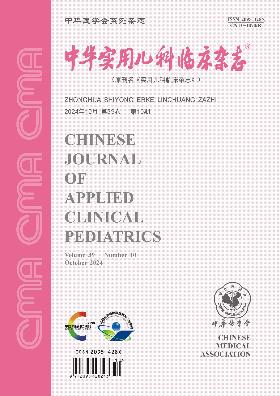Risk factors for prolonged glomerulonephritis after acute post-streptococcal glomerulonephritis
Q4 Medicine
引用次数: 0
Abstract
Objective To investigate the risk factors for prolonged acute post-streptococcal glomerulonephritis(APSGN) in children, and to provide evidence for the prevention and treatment of chronic kidney diseases in children. Methods A retrospective analysis was performed on the patients who were diagnosed as APSGN and hospitalized in the Department of Nephrology and Rheumatology of Hunan Children′s Hospital from January 2005 to August 2017 with complete clinical data, and follow-up time of more than 12 months.The patients were divided into the non-prolonged group and the prolonged group according to whether the disease course of the children exceeded 1 year.Logistic regression analysis of the high-risk factors for the prolonged disease was conducted. Results Among 271 children included in the study, 197 cases were males, 74 cases were females; with the median age of 9.91 (7.66, 11.33) years old; there were 154 cases in the non-prolonged group (course of disease < 1 year) and 117 patients in the prolonged group (course of disease ≥1 year). Logistic regression analysis showed that duration of proteinuria ≥8 weeks, acute kidney injury, a large amount of proteinuria, and female were the risk factors for the prolonged APSGN (all P<0.05). Giving 1 point to the acute kidney injury duration of proteinuria ≥8 weeks and female, and 2 points to a large amount of proteinuria, the receiver operating characteristic curve analysis showed that for patient whose risk score was 3 points or more, the sensitivity of APSGN to be belonged was 43.6%, specificity was 86.4%, and positive predictive value and negative predictive value were 70.8% and 66.8%. Conclusions Patients with a large amount of proteinuria accompanied by acute kidney injury or proteinuria duration ≥8 weeks, or female patients with a large amount of proteinuria, or female patients with acute kidney injury and proteinuria duration ≥8 weeks, but without a large amount of proteinuria, have a higher risk of prolonged APSGN. Key words: Acute post-streptococcal glomerulonephritis; Persistent; Child急性链球菌感染后肾小球肾炎并发长期肾小球肾炎的危险因素
目的探讨儿童长期急性链球菌性肾小球肾炎(APSGN)的危险因素,为预防和治疗儿童慢性肾脏疾病提供依据。方法对2005年1月至2017年8月在湖南省儿童医院肾风湿科住院的临床资料完整、随访时间超过12个月的APSGN患者进行回顾性分析。根据患儿病程是否超过1年,将患者分为非延长组和延长组。对长期患病的高危因素进行了Logistic回归分析。结果271例儿童中,男性197例,女性74例;中位年龄9.91(7.66,11.33)岁;非延长组154例(病程<1年),延长组117例(病程≥1年)。Logistic回归分析显示,蛋白尿持续时间≥8周、急性肾损伤、大量蛋白尿和女性是APSGN延长的危险因素(均P<0.05),受试者操作特征曲线分析显示,对于风险评分为3分或以上的患者,APSGN的敏感性为43.6%,特异性为86.4%,阳性预测值和阴性预测值分别为70.8%和66.8%,APSGN延长的风险更高。关键词:急性链球菌性肾小球肾炎;持久的;儿童
本文章由计算机程序翻译,如有差异,请以英文原文为准。
求助全文
约1分钟内获得全文
求助全文
来源期刊

中华实用儿科临床杂志
Medicine-Pediatrics, Perinatology and Child Health
CiteScore
0.60
自引率
0.00%
发文量
14243
期刊介绍:
Chinese Journal of Applied Clinical Pediatrics ( semi-monthly ) is a core journal of paediatrics under the supervision of China Association for Science and Technology, sponsored by Chinese Medical Association and undertaken by Xinxiang Medical College. Founded in 1986, it is openly circulated both at home and abroad. The journal has several columns, such as Expert Forum, Experimental Research and Paediatric Surgery, which are mainly for paediatric medical workers and medical researchers in hospitals. Its purpose is to reflect the new theories and technologies in paediatric medicine and scientific research at home and abroad, and to promote academic exchanges.
Chinese Journal of Applied Clinical Pediatrics is a source journal of China Science Citation Database (CSCD), a core journal of Peking University, a source journal of Chinese science and technology paper statistics (China Science and Technology Core Journals), a core academic journal of RCCSE, a high-quality scientific and technical journal of China, a high-quality scientific and technical journal of China Association for Science and Technology, and a high-quality scientific and technical journal of China Biomedical Science and Technology Association. We have been published in China Biomedical Literature Database (SinoMed), China Knowledge Network, Wanfang Data Knowledge Service Platform, China Academic Journal Abstracts, Scopus Database, Chemical Abstracts (USA), Japan Science and Technology Agency (JSTA) Database, Copernicus Abstracts (Poland), Abstracts of the Centre for Agricultural and Biological Sciences (CABS) of the United Kingdom, Cambridge Scientific Abstracts ProQuest Database, WHO Medical Journal of the Western Pacific Region (WMPR), and WHO Medical Journal of the Western Pacific Region (WMPR) of the United States. We have been included in dozens of authoritative databases at home and abroad, such as WHO Western Pacific Region Index of Medicine (WPRIM), Ullrich's Guide to Periodicals, and so on.
 求助内容:
求助内容: 应助结果提醒方式:
应助结果提醒方式:


